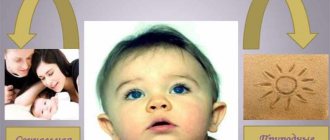No matter how big or small we are, almost all of us have experienced some kind of trauma in childhood.
Such injuries could be: your favorite toy was thrown into the trash; you were abandoned by your childhood best friend; physical or emotional abuse from parents or adults.
Working with the inner child is a vital component of soul work because it reconnects us with the wounded element of ourselves - the inner child. When we reconnect with this fragmented part of ourselves, we begin to discover the root of many of our fears, phobias, insecurities and self-sabotaging life structures.
You will probably be surprised at what you will discover as you work with your inner child. Instead of just looking at the symptoms of your pain, you will go straight to the core and identify when a fear, phobia or a certain way of life began to form.
First, it is important to understand that there are different types of childhood trauma. They include physical (including sexual), emotional and mental trauma. Also, when childhood trauma was too severe or repeated so many times that the soul was lost behind these traumas. Soul retrieval is the process of “retrieving” hidden or inaccessible parts of the soul.
However, not all childhood traumas lead to “loss of soul,” but they may well lead to a wounded psyche. This can lead to problems such as depression, anxiety, low self-esteem, phobias, destructive behavior patterns and even chronic diseases.
What is important to know about the inner child?
The inner child is a “part” of our personality. Which stores all our memories, feelings, needs, reactions, attitudes towards ourselves and others, patterns of behavior that we have preserved from our childhood.
When we react to some situations in the same way as we did in childhood. Then we react from our inner child.
If in childhood some of our important psychological needs were not satisfied, then our inner child “gets stuck” and cannot further grow and develop.
Types of inner child
Our inner child can be different. We can say that there are different parts of children in us, in our psyche. For example, we have:
- An adaptive child is a child who adapts to his parents, obeys their rules, and tries to meet their expectations. Also, an adaptive child can manifest itself in us as a rebellious child, when we, on the contrary, try to rebel against these rules, do the opposite.
- And a free child is a child who behaves the way he wants. Regardless of parental rules and expectations. He does not try to obey or rebel against his parents' demands. And you behave freely and naturally.
We can also have children of different ages inside us:
- An unborn child - which retains the memory of our intrauterine development.
- Inner baby.
- Young child (1-3 years).
- The child is a preschooler (4-6 years old).
- Child 7-10 years old.
- Inner teenager.
There may also be inner children within us:
- A happy child is a child whose needs are met. Which is allowed to manifest itself and develop naturally. Who is loved and supported.
- A traumatized, wounded inner child is a child who was born and formed as a result of the fact that our needs for love, acceptance or security were not met.
- A playful child is a child who loves to have fun, play, and act naturally and spontaneously. He loves to learn new things and is delighted with different adventures.
- Magical – very creative. Likes to fantasize and come up with something new and interesting. He is a dreamer.
- A feeling child is a child who experiences feelings and knows how to empathize with others. It is responsible for our capacity for affection and love.
- Angry - vindictive and vindictive. Tends to punish other people and get angry with them. He is responsible for our ability to defend ourselves.
- A forgotten inner child is a child with whom contact has been lost, who has been forgotten. A forgotten inner child can lead us as adults to crises, depression, and a feeling of meaninglessness and uselessness of our own lives.
The Wounded Inner Child and Relationship Trauma
The traumatized, wounded inner child is a part of us that carries the imprint of our psychological traumas.
Trauma is our psychological wound. This is our reaction to some event or to many similar events that our psyche could not cope with. And as a result, it was divided into a traumatized part (i.e., our wounded inner child) and a part of the protector, the persecutor.
Such a traumatic event could be:
- something extreme. For example, an attack, a fire, a war, someone’s murder, a natural disaster, etc. Then we develop a shock trauma.
- as well as many unpleasant, “softer” events, but recurring regularly. For example, psychological violence, violation of agreements on the part of the parent, lack of attention, rejection, non-acceptance of certain qualities, etc. As a result of such events, we develop developmental trauma or, in other words, relationship trauma.
Our traumatized inner child encourages us to experience again and again similar painful events that caused us to be traumatized. To finally do something differently about this event and heal. And another part of us, our inner defender, seeks to avoid such an event. Protect us from recurrence of trauma.
This inner protector, which protects us from repeating relationship trauma, can manifest itself through fear of intimacy. When we are afraid to let another person close to us or are afraid to enter into a relationship at all. Our fear of close relationships is formed precisely as a result of relationship trauma.
The healing of the inner child occurs through the healing of its “wounded part.” That is, through working with relationship trauma. And as a result of his healing, our ability to have close, trusting, loving relationships with other people increases.
How to work with your ego state?
There are not so many methods for working independently with the child within yourself. In addition to simulating conversations, psychologists recommend:
- writing letters to the child and replies to them on his behalf;
- meditation;
- awareness of one’s true needs and interests, their embodiment;
- destruction of psychological barriers.
All these methods are suitable for people who are thinking about how to grow up their inner child. Fixation of the ego state at a certain age occurs not so much because something extraordinary happened at that moment in the past, but because the person has locked away the memory of it.
Those who have experienced happy moments try to stay in them forever. Those who have received emotional trauma are terrified of its repetition, so they do not let go of their experiences and record them in order to recognize approaching troubles in time.
How does the inner child manifest itself in a relationship?
Often our inner child in relationships manifests itself through some very strong emotional reactions. For example, when we become very scared. Or very sad and painful.
It can also manifest itself in us through the patterns of behavior that we used in childhood in relationships with our parents.
For example, a woman makes serious mistakes at work over and over again. Because of which her boss constantly scolds her. As a little girl, this woman behaved the same way with her mother. Who only paid attention to her when she did something wrong. And in order to receive at least negative attention from her mother, the girl deliberately made mistakes.
And having already matured, this woman unknowingly continues to receive attention from her boss (who even looks like her mother). Because she scolds her for her mistakes.
All that shortage of what we were “lacked” in childhood. We retain all this emotional “hunger” in ourselves into adulthood. And we unconsciously look for people with whom we can “play out this drama”, repeat this painful scenario. A scenario where we need something from another person, but he cannot or does not want to give it to us. Or he gives, but you have to “pay for it” very dearly.
Why look for your inner child?
Each of us has an inner child Finding and Getting to Know Your Inner Child. Communication with him can make your life more prosperous and bring ease into it.
Diana Raab, Doctor of Psychology, in a comment to Healthline
When the inner child is “healthy,” it usually does not cause trouble in adulthood. But if he is “wounded” 3 Therapies to Heal Your Wounded Inner Child, the person may repeat the wrong behavior patterns taught in childhood. For example, a little girl who saw her mother suffer violence from her father may herself become involved with an abuser as an adult.
Communication with the inner child allows you to find the roots of current problems in childhood and get rid of them. Some people end up with the following in the process: What is the “Inner Child”? :
- release repressed emotions;
- recognize unmet needs;
- change incorrect behavior patterns;
- loosen up;
- increase self-esteem.
Why do you need to work with your inner child?
First, working with your inner child is important to make it easier to build loving relationships.
People who have a severely traumatized inner child most often use one of two strategies for dealing with it:
- They can “hide” their inner child from themselves, i.e. “suppress” it within yourself, not allowing it to show up or manifest itself. Or “hide” only from other people, not allowing others to see themselves as such - vulnerable, needy, sensitive and loving. If we do not allow our inner child to express itself in relationships with other people, then it is difficult for us to become attached and close to another person. We become unavailable to other people, emotionally closed.
- Or people may, on the contrary, unconsciously shift all the care of their “inner child” to other people in the relationship. At the same time, without even checking how safe and reliable the other person is to come so close to them. With such a strategy, firstly, there is a very high risk of “getting hurt”, being seriously injured in a relationship. Become attached to a person with whom it is unsafe to be in a relationship. And secondly, it can be difficult for other people to take care of us all the time. Moreover, without receiving anything in return. After all, adult relationships are based on equal exchange. And when there is no balance between “taking” and “giving,” then the relationship between two adults turns into a “parent-child” scenario, becoming unhealthy. Either the person gets tired of taking care of us all the time and moves away or breaks up with us.
Both of these strategies interfere with creating a happy relationship. And to replace these strategies, you need to work with your inner child, heal it and learn to give it love, security, care and attention.
Good contact with the inner child helps us to rely on ourselves, to be more self-sufficient, and not to become heavily dependent on other people. Helps you recognize your desires and act in accordance with them.
It also helps us to be creative. Difficulties with creativity in a person arise precisely because a person suppresses his inner child and does not allow him to manifest himself.
Preface
There are topics that seem to find you themselves... This happened to me and with the topic of healing the Inner Child in an adult. For some time I had been toying with the idea of classes and groups on this topic, but did not dare to start conducting them. Something constantly “forced” me to postpone the start of these classes.
One sunny winter day, my good friend called me and asked - do I still want to teach such classes? I once shared my thoughts with her on this matter, told her about the exercises that I had come up with or found and which I was gradually testing with my clients.
“Of course,” I answered, “as I want!”
“Well, I’ve gathered a whole group of people who want it for you.” What day and time are you available?
I couldn't believe my ears. I didn’t believe it at all - how did it happen, without any effort on my part (unless, of course, you count the efforts in work, collecting material, studying at various courses and trainings - there were just a lot of these efforts), a group of participants gathered, a room was found - for me All that remained was to come and conduct these classes. This is how my first group to work with an adult’s childhood took place. Much has changed since then; now I lead long-term groups and conduct individual consultations with adults. Only one thing has remained unchanged - my deep interest in this topic and my belief that our society needs psychologically healthy adults. And to do this, you need to look at your past and help yourself finally grow up, with more care and warmth towards your child self.
Almost eight years after I began leading Inner Child healing groups, I decided to write a book. As a university teacher and a person with an academic degree, I wrote many different texts: texts of scientific articles and dissertations, texts of lectures, methodological and teaching aids. As a child, I dreamed of writing books; all the most beautiful general notebooks, which were not so easy to find at that time, were filled with my stories and poems. When my son was born, we wrote various fairy tales with him, I wrote short stories for him. And now I write articles for the forum where I advise users, and articles for my website. And most of all I love to write artistic sketches, some of which you will find in this book.
But creating just such a text was a special experience for me. It became a time of new discoveries, unexpected personal growth and a review of everything I did for this. These were nights of reflection, immersion in a state of “flow”, when it seems that the book speaks through you, rather than you writing it. Probably those who write such books will understand what I mean. And, of course, I really hope that this book will be necessary and useful to many. Moreover, now various psychologists talk and write that one of the most important and necessary stages of inner work is precisely getting to know your Inner Child, healing its wounded part. This is necessary for parents who do not want to pass on trauma to their children; it is necessary for all those who have decided to change the quality of their life for the better.
Before each new group dedicated to working with an adult’s childhood, I always go to the supermarket. I’ve been leading these groups for eight years now, and I know for sure that you definitely need to stock up on handkerchiefs. That’s why I take several packs of paper tissues at once. What else? Pencils, paints, drawing paper. The group gathers with virtually no announcements on social networks or advertising, and every year I always worry about this group. What kind of participants will come? This group is usually attended by people who carry a lot of pain inside them. We all come from childhood, and we are all - one way or another - wounded by it... Some more, some less, but, probably, we all have situations and problems that stem specifically from childhood and resonate in the soul with varying degrees of pain... I practically never saw people who were not wounded by their own childhood. And amazing things happen in these groups. And to this day they never cease to amaze me. Starting with how the group members are selected. It seems that all the people don’t know each other, they were chosen by chance, but how sometimes their life stories overlap... In one of my first such groups, all the participants had fathers who suffered from alcoholism. On the other, most of the participants were raised by single mothers; I had a group of excellent girls, medal winners, with honors, a group of women who were brutally beaten by their fathers in childhood, and there was also a group where most of the participants were sexually abused in childhood. The group included people who had gone through severe trials and trauma. And, nevertheless, giving each other support and strength to live on, to cope with what they had to and sometimes still (unfortunately) have to deal with in their lives.
This group is called “Healing the Inner Child”. And the book that is in front of you is the result of all those years of work that I want to share. First of all, I wanted to write it for the participants who had already gone through work in therapeutic groups, since periodically they asked me - are all those exercises, everything that we talk about in our meetings, in some book? And I would really like to have such a book as support and self-support, so that I could open it and remind myself that in each of us there lives an Inner Child who is worth remembering and caring for. Participants often told me, even years later, how their quality of life had changed after working with their childhood problems. And now this book is in front of you.
But if there was “nothing that terrible” in your childhood, should you pick up this book?
I invite you to look at the list of statements and note which ones you could answer “yes” to:
1) You have low self-esteem and often doubt whether you are a good person.
2) When everything is going well in your life, you begin to experience an incomprehensible melancholy and internally constantly prepare for trouble.
3) It is difficult for you to refuse people, to say “no” to them without feeling guilty.
4) It is often difficult for you to understand what you really want; you have difficulty making even the most insignificant decisions.
5) You consider yourself unworthy of success, and when it comes, you think that you did not achieve it deservedly.
6) You often experience an inexplicable feeling of shame.
7) You put your needs last because putting them first means you are being selfish.
 You try to predict the thoughts and actions of others.
You try to predict the thoughts and actions of others.
9) You feel guilty for not living up to your parents' expectations.
10) You believe that the happiness of your parents depends primarily on you.
11) If you feel irritated and angry towards your loved ones, then for a long time you fall into a feeling of guilt for this.
12) You believe that the other person is more important than yourself.
13) It is difficult for you to relax, allow yourself to have fun and relax.
14) You do not believe in the sincerity of compliments addressed to you and consider yourself unworthy of them.
15) You try to show others that everything is fine with you, even if this is not the case.
16) You feel like you are not a good enough parent for your children.
If you answered “yes” to most of these statements, then it is possible that this book can help you too.
The book consists of chapters, at the end of which my own artistic sketches are offered, illustrating some theoretical positions. At the end of each chapter there are also exercises - a kind of workshop. I will tell you further about how to use it.
I would like to say a few words about exercises. I came up with some exercises myself, some I took from my colleagues from whom I studied, some were taken from books and modified by me to suit the specifics of working with this topic. I must say, ideas are in the air. So, for example, I once came up with an exercise with a photo album, and then I saw a very similar one in collections of exercises dedicated to psychological games and training.
If you are holding this book in your hands, it means that you are ready to touch on a reverent topic - the topic of interaction with your inner child. I highly recommend that you do these exercises with someone - and it is best if you do them with the support of a professional psychologist. Of course, everyone has different situations, and you can do them with a close friend or with yourself (then I recommend that you write down your impressions after each exercise). So, bon voyage. On the way to your own childhood...
Loving yourself means loving your inner child.
If you feel that you don't love yourself or don't love yourself enough, then you need to work with your attitude towards your inner child.
Most likely, you don’t love yourself because you have adopted someone else’s negative attitude towards yourself. Someone significant to you as a child treated you in a way that made you feel like they didn't love you. And in childhood, we put the external inside ourselves, absorbing it like a sponge. And you also absorbed someone’s unloving attitude towards yourself, and learned to treat yourself in the same way.
And now, as an adult, you continue to treat yourself the same way, i.e. to your inner child.
How to communicate with him?
If the Inner Child is forgotten and abandoned , the person:
- withdraws into himself and ceases to feel confident in society;
- hides his true feelings (whether it be shame, a desire to find gain, or a fear of being uncomfortable);
- from time to time a person feels tired;
- sometimes there are attacks of uncontrollable irritation;
- you have to force yourself to do certain things.
To purposefully start communicating with VR, you need to enter a state of relaxation .
To do this, you can meditate or simply stay alone and disconnect from the outside world, forget about your problems.
- Use images to communicate , because a creative Child readily responds to them. You can imagine a clearing, a corridor or a castle into which you invite VR for a conversation. Colorfully imagine your path to this place, the awe of the upcoming meeting.
- The child may already be waiting for you at the appointed place, or appear a little later. Please be patient .
You may not be able to connect with the ego state the first time if you have always ignored it before. - When the Child comes to the meeting, repent to him . Ask for forgiveness for always leaving him unattended and often trying to suppress him. BP must accept your apology and respond affirmatively to the friendship request.
- Now that VR has become your friend, you can communicate with it directly , listening to your emotions online.
Why don't mothers love their daughters? Read about it here.
Develop a loving inner parent
Healing of the inner child occurs through a loving attitude towards him. To learn to treat him with love, it is important to develop a loving and caring inner parent. In return for that critical, non-accepting, rejecting parent who is now inside you.
This process is not quick. You can't just do something today and wake up tomorrow with a loving inner parent. Long-term regular work is required for this. But if you really carry it out, then you won’t even notice how you will become more stable and filled with love.
Working with the inner child. Exercises
First exercise To begin, do this work with your unborn inner child. To heal the traumas you suffered during the prenatal period.
- Imagine yourself as an adult, as a mother to your inner child. And that within you is your unborn inner child. It is important to imagine not your real mother, but yourself, as a mother to your inner child. Feel your warmth, love and tenderness for this child who is inside you. Stay with these feelings for a while.
- Then feel yourself as this unborn child. And feel love and tenderness for your mother with your whole body. Feel that you love your mother (not your real mother, but yourself, as your own mother), and your mother loves you. Feed yourself on these feelings.
- As you observe this communication between mother and inner child, periodically change your role. Either feel like a mother or a child. And feed off the love they feel for each other.
Repeat this exercise every day for a month. And then take the next age period - infancy. Repeat this exercise with your inner baby. And do it every day for a month. And then repeat everything with your inner child of early childhood, preschool age, elementary school age and your inner teenager.
Second exercise
In order for your inner child to feel his worth and feel worthy and good, it is important to praise him. And do it regularly.
For this you can keep a notebook. In which, every day, write down 5-15 points for which you praise your inner child today. It is important to repeat this exercise every day for at least a month. It is important to do this regularly and not miss days, so that you learn to praise yourself automatically, so that you develop such a skill.
Healing the inner child
- If you have never worked with your inner child before, then first you need to get to know him. To do this, you can write him a letter. Or imagine that he is sitting in front of you. And looking into his eyes or in a letter, greet him and tell him everything you want to say.
- Find out from your inner child what he needs, what he wants. And find a way to give it to him. It is important that this is not a one-time job, but constant and regular.
- Analyze your relationships with people and determine which needs you most often cannot satisfy in your relationships. But you want it. Maybe it's the need for a stable and secure relationship. Or the need for recognition and praise. Or the need for warm touches and hugs. Or the need for freedom. Or the need for attention.
To change your relationships, make them happier and more nourishing, it is important to learn how to give this to yourself, to satisfy these needs for yourself. It is important to learn to notice and find people who are able, willing and able to give you what you need. Learn to talk to others about your needs and ask for them. Learn to satisfy these needs from other people yourself. And also learn to build such relationships with them that other people want to do something nice for you.
- Sometimes organize holidays for your inner child. When you do something for him all day long, pamper him and make him happy. For example, buy yourself balloons, treat yourself to cotton candy, sing yourself a lullaby, ride yourself on a carousel or swing. Give him a doll or a car, play with him and other children, watch your favorite cartoon. Take yourself to a water park, circus or dolphinarium, do something creative. Embrace yourself or the image of your inner child in your imagination. If as a child you dreamed of something, and on this day you can make this dream come true.
- Watch the feature film “Big Little Me” and do similar work with your inner child, as the heroine of the film did.
It is better to work with the inner child (and especially with its “wounded part”) together with a psychologist. If you want to learn to be more loving with yourself. And become more self-sufficient, happier and more stable in relationships through working with your inner child. Then contact me for personal consultations.
Definition of the concept
What is an inner child in psychology, what does it mean? The inner child is a collective image that includes children’s psychological beliefs and a person’s ideas about the world and himself.
Parents help their child understand the following:
- what he is like and what awaits him;
- how it is accepted and how it is not accepted;
- what he is capable of and what he is incapable of.
Some people are luckier: parents give enough love and take a reasonable position in matters of upbringing. But some are less fortunate: parents instill in the child the idea of his worthlessness, insolvency, “badness,” and uselessness. The former develop the attitude “I am good, and the world is safe”; the latter, “I am bad, the world is dangerous.” The first ones know how to trust people, value and love themselves. The latter do not accept themselves and do not trust other people.
A child lives inside every person. He is responsible for our “wants”, openness and spontaneity, sincerity, emotionality. Remember how children behave. They are free from social masks. Children know how to be happy just like that, and express their thoughts directly. They put their desires at the head of the table. They are free to express themselves.
Gradually, under the influence of upbringing, the child gets used to following social norms, limiting his desires, and suppressing emotions. Being an adult is boring. For all the moments of joy and fun, you can thank the child within you. However, sometimes, due to trauma and a difficult childhood, a person grows up depressed and sad. He does not know how to rejoice, express his emotions, love, or be open.
What traumatizes a child?
Imagine the stress a child experiences at the moment of birth, the horror that engulfs him. For nine months he lived in ideal conditions, complete safety and comfort. And suddenly he finds himself in some new world, where hundreds of irritants fall upon him. All he needs is to regain a sense of security again. The mother’s task is to help the baby feel safe, to form the attitude “Mom is fine, everything is fine with me, everything is fine in the world.” Problems with safety (physical, mental, emotional) lead to traumatization.
For example, the following (parental mistakes) are traumatic:
- coldness and distance from parents and other significant adults;
- systematic violation of personal boundaries (physical and emotional violence);
- systematic punishment and suppression, prohibition on the expression of opinions and emotions;
- irrational criticism and insults, especially in public;
- transferring responsibility to the child, taking out your pain on him (“Because of you, I did not become a successful doctor,” “Because of you, my husband left me,” “Shame on you, you shame me all the time”).











